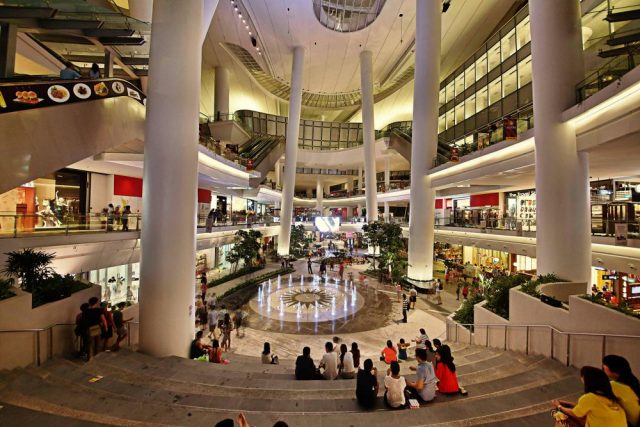CapitaLand announced today that it has entered into an agreement to sell The Star Vista for S$296 million to Rock Productions, owner of The Star Performing Arts Centre that is co-located with The Star Vista in the same development.
Based on the latest independent valuation, The Star Vista was valued at S$262 million as at 30 June 2019. The divestment is targeted to be completed by end 2019 and is expected to generate for CapitaLand net proceeds of approximately S$145 million and a net gain of approximately S$32 million.

Mr Jason Leow, President, Singapore & International, CapitaLand Group, said: “The divestment of The Star Vista is in line with CapitaLand’s active and disciplined asset recycling strategy. Year to date, CapitaLand has divested close to S$5.7 billion worth of assets, exceeding our annual target divestment of S$3 billion. The proceeds from these divestments will enhance CapitaLand’s financial flexibility to seize new growth opportunities.”
Upon completion of this transaction, CapitaLand will own 19 malls, including one under development, in Singapore.
Located next to the Buona Vista MRT Interchange, The Star Vista is part of a 15-storey integrated development which also includes a 5,000-seat auditorium.
Opened in September 2012, the The Star Vista comprises three levels of retail space – two levels above ground and one basement level – with a net lettable area of about 162,500 square feet.

The mall registered an occupancy of 95% as at 30 June 2019. Its major tenants include Beauty in the Pot and LeNu, Canton Paradise Teahouse, Redman by Phoon Huat, Swee Lee and Cold Storage.
As landlords and retailers come to terms with the disruption posed by e-commerce, retail malls are rapidly evolving beyond a transactional model to embrace community building through experiential and activity-based concepts.
A recent report by Edmund Tie said that while Singapore’s GDP and household incomes have steadily recovered since the 2009 global financial crisis, rising at a compounded annual growth rate (CAGR) of over 4%, retail and F&B growth has however not kept pace, with annual growth barely reaching 2% over the same period.
In a bid boost footfall, maintain high occupancy rates and shore up tenant sales and operating profits, retail malls are adding communal spaces and non-retail components into their mix, with the aim of creating communities within their premises.
“Online commerce has given consumers an unprecedented luxury of choice and convenience through social shopping, peer-to-peer influence and round-the-clock access to vast repositories of information,” said Ms Ong Choon Fah, Edmund Tie’s chief executive officer.
“In response to the changing landscape, landlords and retailers are giving customers reasons to visit over and over again. Physical retail is differentiating itself by furnishing experiences that their online counterparts can’t offer, and integrating online-offline retailing by adopting an omnichannel approach,” she added.
Increasingly, retail malls are featuring focal points – which may not even be retail in nature – around which people can gather. The recently reopened Funan Mall, for example, offers a publicly accessible rooftop Urban Farm, rock-climbing facilities, a futsal court and even an indoor cycling track on top of an impressive array of F&B outlets and flagship brands. From a nondescript lineup of IT stores, Funan has evolved far beyond a hangout for techies to become a vibrant space where shoppers, families and hobbyists can shop, eat and play.
The iconic Rain Vortex, the world’s tallest indoor waterfall at Jewel Changi, attracts huge throngs seeking “Instagrammable moments”, while the mall’s Canopy Park and Hedge Maze are compelling play attractions designed to encourage consumers to step out of their homes and return to the shopping centre.
In line with the town-centre concept, the award-winning The Commons community mall in Bangkok likewise features ample room, amounting to some 5,000 sq m (or 53,800 sq ft), for open communal uses including family-friendly play areas and space for regular events and activities such as cooking workshops, live music and community gatherings.
In addition to community building, pop-up retail, which originally served as testbeds for new products or e-businesses taking a leap into brick-and-mortar, is now fast gaining traction even among established brands, and offers another avenue through which physical retail can attract footfall.
Ms Chua Wei Lin, Edmund Tie’s executive director and regional head of business space said: “Defined by a continually changing mix of merchants and brands, pop-up retail gives malls the opportunity to offer additional options on top of their existing retail mix. Its ever-changing nature creates a sense of novelty and excitement that will attract shoppers.”
Funan’s Tree of Life, for example, is an impressive centerpiece that comprises 20 retail pods, allowing both emerging and established brands to showcase a variety of products and services for limited periods before being refreshed again. Bangkok’s ICONSIAM likewise offers SookSiam, a co-creation and cultural space spread over a sprawling 16,000 sq m (or 172,200 sq ft), which rotates indigenous entrepreneurial set-ups for maximal diversity.
“Notwithstanding geopolitical, macroeconomic and technological headwinds, physical retail remains highly relevant,” said Ms Ong. “In 2018, brick-and-mortar stores accounted for more than 90 per cent of retail sales, and the importance of physical retail is further corroborated by the fact that established online merchants – such as Taobao and Love, Bonito – have expanded into physical stores. Indeed, malls are now evolving to become the third place where people gather to relax and socialise.”






